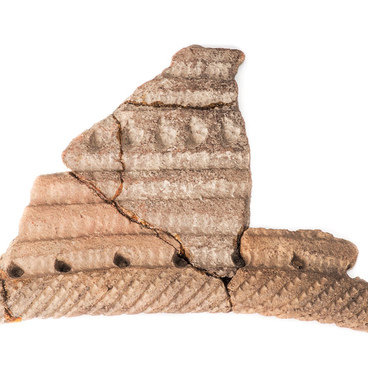A composite dagger from the Late Neolithic era, which was created 4.6-5.2 thousand years ago, was found at the excavations of the Isakovo burial ground on the bank of the Angara River in the Bratsk district of the Irkutsk region. There, archaeologists discovered a solitary burial covered by masonry. Underneath it, were human remains, as well as jewelry, tools, arrowheads, and also a dagger from the museum’s collection.
Similar implements have been found at many archaeological sites in Siberia. On both sides of the pointed bone part there were grooves for inserts and plates inserted into them. The knives were placed in the burials in a certain way: either near the head with the point upwards, or in the area of the pelvic and femoral bones.
The Isakovsky burial, where the dagger was found, was explored from the 1930s to the 1950s during the rescue work on the Angara river. Before the construction of the Irkutsk and Bratsk hydroelectric power plants, archaeologists were invited to the flooded area to study the ancient objects found there. The excavations were led by the Irkutsk scientist Aleksey Okladnikov. He discovered the Isakovo burial ground and, on the basis of his findings, proposed to identify a separate stage of the Siberian Neolithic — the Isakovo stage.
Okladnikov concluded that there were certain traditions in the Angara Region (Priangarie), which he also described as the Isakovo culture. They covered different areas of life. Following these traditions, the locals made pottery, used certain tools, buried their dead and placed special objects in the grave. As the archaeologist wrote about the findings,
Similar implements have been found at many archaeological sites in Siberia. On both sides of the pointed bone part there were grooves for inserts and plates inserted into them. The knives were placed in the burials in a certain way: either near the head with the point upwards, or in the area of the pelvic and femoral bones.
The Isakovsky burial, where the dagger was found, was explored from the 1930s to the 1950s during the rescue work on the Angara river. Before the construction of the Irkutsk and Bratsk hydroelectric power plants, archaeologists were invited to the flooded area to study the ancient objects found there. The excavations were led by the Irkutsk scientist Aleksey Okladnikov. He discovered the Isakovo burial ground and, on the basis of his findings, proposed to identify a separate stage of the Siberian Neolithic — the Isakovo stage.
Okladnikov concluded that there were certain traditions in the Angara Region (Priangarie), which he also described as the Isakovo culture. They covered different areas of life. Following these traditions, the locals made pottery, used certain tools, buried their dead and placed special objects in the grave. As the archaeologist wrote about the findings,



